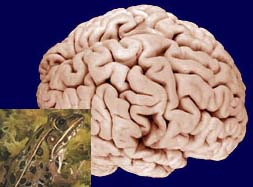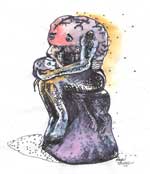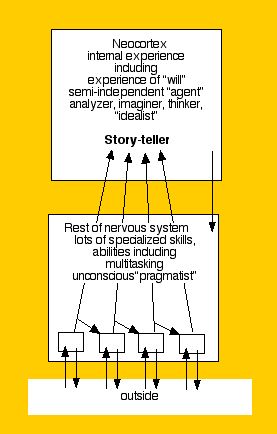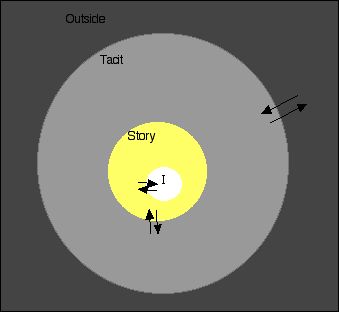Serendip is an independent site partnering with faculty at multiple colleges and universities around the world. Happy exploring!
BBI 2007 - Session 13

|
|

|
BRAIN AND BEHAVIOR INSTITUTE 2007 |

|
Architecture: From the Input Side
Review: a shifting perspective, the cognitive unconscious and the I-function -> story teller
"The idea of loops creating a system that seems to have a purpose is fascinating." ... Cheryl
"Today's discussion makes me want to pay more attention to my unconscious behavior in the classroom and to teach myself to be more aware of my "I" function. I hope to use my I function to change some of my stories. I hope to be able to teach my students to be more conscious of their thoughts and behaviors and to be aware of their I function to change their stories. The thought of teaching the kids to be effective casual change agents is very exciting to me!" ... Diane
"In terms of our classrooms I wonder if the children took standardized test unconciously if they would do better. I say that because of the basketball senario, when the children are so nervous they seem to "mess up" on questions they know." ... Dalia
"The question I am leading up to is whether the strengthening of hand-eye movement and hand strength is correlated to the strengthening of the I-function." ... Teresa
"In some cases it seems that even the I function cannot make motion happen." ... Bruce
"As educators alot of practices that we do are unconconscious but do we really view it that way. Our unconscious is writing stories that are conscious may or may not be aware of. It is important that we not hold either as truth but as a story that our unconsious or conscious had made by their different types of summary of observations." ... Angela
"this thought of the conscious and unconscious working side by side is extremely interesting. For me, it is a very positive idea that much of what we do is unconscious. It helps to disspell the idea of "fate". I do not like the idea that I have a plan set out for me. That I am following some sort of script. The idea that not only "I" but the rest of me is doing things to creat a new and ever changing story gives me a stronger sense of self. I think this idea is crucial to us as an educator because it hleps us to understand and appreciate the differences that exsist in our students. It also leads me to feel a sense of hope because it suggests the abilty to change the present stories we have, especially those that are negative ... Is the 'I-function' operational when in a dream state or coma?" ... Keith (see also Victoria)
"Does this mean that we can teach our students to be able to isolate movement and or thought? Can our students be conditioned into being more creative, or does this mean that their brain and or muscle power is, at least to an extent, predetermined by their genetics?" ... Graham (see also Deidre)
"I suspect that Paul's question to his twins is key to the facilitator's role in this process. It got them to pay attention to their bodies and cause change." ... Mingh
"The supposition I understood from today was that I-Function allows us to write new stories that can be creative ways to perform desired results." ... Joyce
"During last weeks' discussion I was starting to feel powerless over the outcomes in my classroom or their impact on the school, and community. Today I feel like I can have a positive impact on making students aware of their conscious and unconscious actions. By making them aware of the things that they do without thinking about them I have a better chance of helping them to account for their total "I" function which in turn will positively influence the classroom, the school, their families and hopefully the community." ... Tammi
"Students at an early age need to be given choices. We need to get into their unconscious and pull up some of the beneficial things that will encourage them to be self motivated not only in their own interests but also about the things that will make them productive citizens in the future." ... Judith
"I think there is a small similarity between the contemporary model way of describing the scientific method and the input-neuron-output-reafferent loop" ... Bob
"Change stories and behavior changes, change behavior and stories change" ... BBI 07
New principles from the input side
- Multiple inputs, unconscious/"I-function" distinction
- Brain "making things up" (see BBI05 and BBI05 with I-function help)
- Built in presumptions of "reality"
- Ambiguity as fundamental
- Testing and retesting, negotiating and renegotiating - all unconscious, doesn't worry about "Truth" or "Reality", just comes up with something that works - "story"
- The "crack"
- Different for different people
- Again an unconscious/"I-function" distinction in abilities/uses
- Perception an exploratory process, testing and retesting
- Using both unconscious and I-function

- From I-function to "story teller", and story creator (making what hasn't been seen)
- Using both unconscious and I-function
Key points:
- Input is always incomplete (and affected by output)
- Input is always interpreted based on prior information (including genetic information)
- Input is always ambiguous
- Interpretation is improved (but not completed) by combining multiple perspectives, resolving conflicts
- Both input and interpretation are different for different people
- What we see is a "story" reflecting unconscious processes
- "Reality" is a collective story, reflecting (desirably) the different perspecties of different people
- Stories can in turn generate new questions/observations/stories, and new stories (that in turn ...)



Comments
Unconscious/Conscious
I understand the question that if the kids took the PSSA unconsciously, would they do better? I would like to take all of this info concerning, inputs, outputs, stories, I Function, emotions, etc to teach them to look at things consciously at first, then practice using this info to to attack test, situtations, etc unconsciously. This way they have had the time to practice how they will react to something stressful (PSSA). WHen the time comes to take the test, or react to someother stressful situation they are ready for it.
OK, Where do I start?????
The Matrix
Tuesday's Comments
Filling in the Black holes
input side of NS
Storytellers, live...
What interesting storytellers our brains are! Our morning session today on inputs into our brains really showed how much of our sensory inputs are "told" to us by our brain/nervous system; we are simply along for the ride. It was really interesting to me to see how much the brain tells us stories about our surroundings, and uses a few basic observations to fill in the gaps.
The obvious implication, then, for us as educators, is that our students' brains may very well also be filling in the gaps based on a few observations they may make in class. We need- not only to do this ourselves- but also encourage our students to do the same- practice "getting it less wrong" by going back and editing and looking where our students' brains are spinning stories live, and encourage in our students the ability to self-check to make sure that we do indeed "get it less wrong", rather than get taken for a ride by our brains and nervous systems.
Vision and multiple images.
Our Perceived World
Input
Post new comment